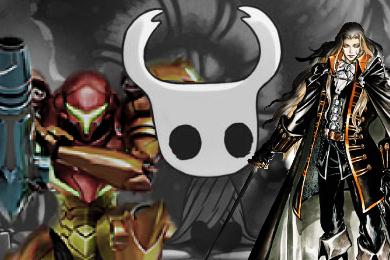A Metroidvania game combines the exploration and discovery of a platforming game with the access-restricted progression of a labyrinth. These games are often referred to as “platform-exploration” games or “action-adventure” games, but the most common descriptor is “Metroidvania”.
This refers to combining elements from the Nintendo game “Metroid” (marketed as Action-Adventure) and the suffix used in so many Castlevania games -vania.
The result is a type of game that has become quite popular. Given how interconnected these two franchises have become, it’s probably not surprising that we see this blend so often.
After all, both series are known for their labyrinthine castles and labyrinthine castle variants on multiple separate islands, with an emphasis on exploration and discovery along with lock-and-key puzzles blocking off new areas until you find new items – be they keys or powers like double jumping or fireballs.

What Makes a Good Metroidvania Game?
A well-made Metroidvania game will have an intricate and challenging labyrinth map design that promotes exploration. Additionally, there will be many unlockable areas that the player will have to figure out how to access. Finally, unlockable skills, gear, items, and the like are key in giving the player the ability to progress through the game.
Below I go into these core features of a Metroidvania game.
Labyrinth Map Design
As we’ve seen, one of the primary characteristics of Metroidvania-style games is that they are built like a labyrinth. The player usually starts off with limited access to various areas of the map, and certain abilities or items must be acquired before other areas become accessible.
Therefore, before you can make a great Metroidvania game, you need to understand how building a good labyrinth works. First of all, a labyrinth is not the same thing as a maze.

The distinction between the two is subtle but important.
A maze is a puzzle, a game of navigation that can be solved by logic and observation – and often has a single correct answer.
A labyrinth, on the other hand, is more like a puzzle of navigation that is navigated by skill. This difference is important because a maze can be reduced to a single path and solved with a map, whereas a labyrinth has multiple paths, no map, and is solved by skill.
Exploration is Key
Like an adventure game, a Metroidvania game is first and foremost about exploring the map. Maps in these games tend to be somewhat open, with lots of interconnected rooms, corridors, and passageways that allow the player to explore and backtrack.
Some Metroidvania games even allow the player to walk through walls or explore multiple floors at the same time. This exploratory nature of the game is reinforced by the mechanic of acquiring the tools and abilities needed to explore more of the map.
Exploration is a key part of the player’s progress in the game, and the acquisition of new tools and abilities is often key to opening up new areas of the map.
Network of Unlockable Doors, Rooms, and Corridors
The map of a Metroidvania-style game is built like a network of unlockable doors, rooms, and corridors. The player usually starts off with very limited access to various areas of the map, and certain abilities or items must be acquired before other areas become accessible.
The most important feature of these networks of doors, rooms, and corridors is that they are interconnected. Ideally, every room, passageway, and door in the game world is accessible from at least one other room, passageway or door.
This interconnected network of rooms, doors, and corridors is often how the player gains access to previously off-limits areas. Perhaps there is a locked door that can only be opened when the player acquires a certain item or power. Perhaps there is a door that can only be opened with a certain key that the player must find.
Resource Management and Acquiring Abilities
As is the case with most games, a Metroidvania game rewards exploration with more resources. The more the player explores and acquires new items, weapons, powers, and abilities, the more they can access the map.
Typically, the player starts off with a basic set of tools and abilities, and exploration leads to the acquisition of more powerful items and weapons that allow the player to access previously off-limits areas.
These resources can also be used in other ways, such as to open up new paths or solve puzzles to advance the story.
Examples of Metroidvania Games
Dead Cells

Hollow Knight

Ori and the Blind Forest

Axiom Verge

Ender Lilies

Aeterna Noctis

Dust: An Elysian Tail

Guacamelee

Yoku’s Island Express

Conclusion
We’ve seen that Metroidvania-style games are built like a labyrinth, with a network of unlockable doors, rooms, and corridors.
The player typically starts off with very limited access to these rooms, corridors, and doors, and certain abilities and items must be acquired before other areas become accessible. This interconnected network of rooms, doors, and corridors is often how the player gains access to previously off-limits areas.
Perhaps there is a locked door that can only be opened by acquiring a certain item or power. Perhaps there is a door that can only be opened by acquiring a certain key. This is the core mechanic of the Metroidvania-style game: exploring the map and acquiring new items and abilities in order to gain access to more of the map.